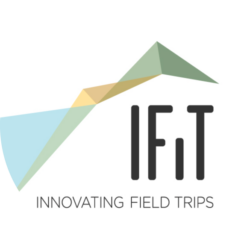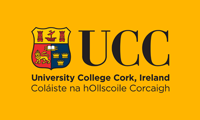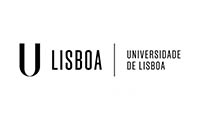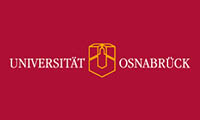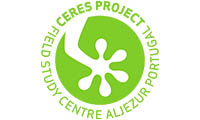Blog
IFiT Student Field Trip May/June 2019 (Blog 3 – Dean Notaro/ German translation: Emma Hadré)
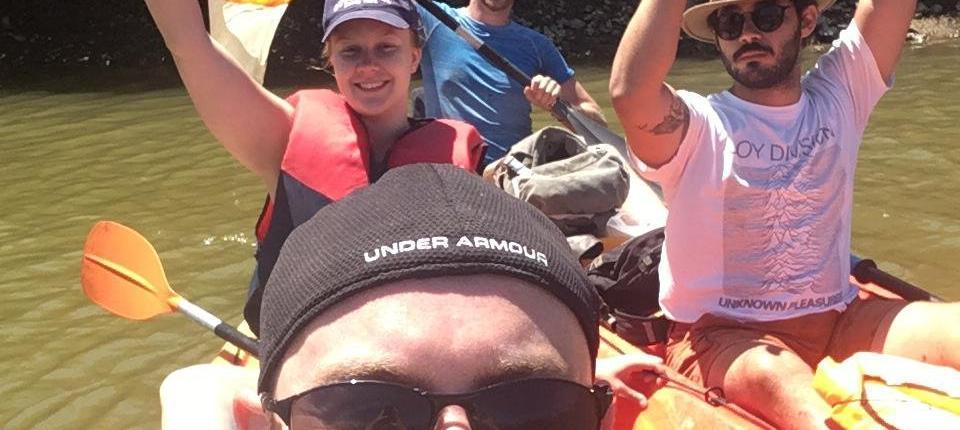
Hello! My name is Dean Anthony Notaro and I am a MSc Marine Biology student at University College Cork (UCC), Ireland. I am currently undertaking research in the area of shellfish health, looking into various therapies which can help reduce bacterial and viral pathogens in shellfish, specifically the Pacific Oyster (Crassostrea gigas).
I am one of four members of the Amoreira estuary team here in Aljezur, Portugal. Our team consists of two biologists from UCC, Ireland, one geologist from University of Lisbon, Portugal and one geographer from Osnabrück University, Germany.
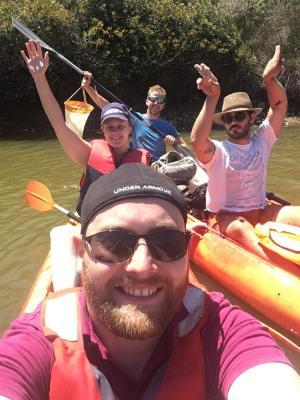
Research via kayaks Photo: Dean Anthony Notaro
As part of our project, we are looking at the different habitats in the Amoreira estuary. We are researching the area’s ecology i.e. vegetation habitats in the sand dunes, as well as the sampling of in-faunal, benthic and planktonic species found in the estuary. In addition, we have been looking at the geological landscape surrounding the estuary as well as proposing land usage ideas, to bring conservation, education and tourism to the area. Our team divided our project into three sections; biological, geological and land use, with each team member getting interdisciplinary experience in each section.
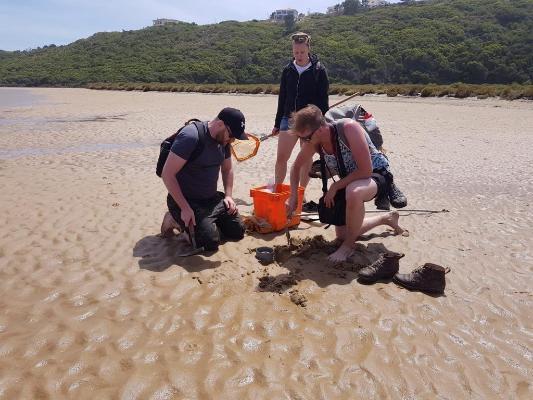
Benthic Sampling Photo: Afonso Thies
For the biological component, we investigated the various plant and animal species inhabiting the dunes (primary, secondary and tertiary dunes) as well as the surrounding sand marsh and island areas. Plant species and vegetation assessment was carried out by creating 25 m2 plots (5 replicates at each site) using the braun-blanquet scale. This method allows for rapid visual assessment of the plant coverage and animals present in each site. For benthic sampling, we used a 15 cm core at 3 different sites (3 replicates per site), with sedimentation nets that removed sediment and allowed us to assess the different in-faunal species. We found various types of amphipods, worms and clams. Plankton nets were used to carry out plankton surveys in the estuary as well as thermometers and refractometers to get an overall picture of why particular species would inhabit certain areas of the estuary. While on the field, we also came across a population of Fiddler crabs (Uca tangeri). This was quiet a nice find, as the crabs were not known previously to inhabit this specific area of Aljezur. We decided to do three random plots (10m x 2m) to assess the number of live crabs in the estuary, the number of burrows as well as the mean surface and burrow (at approx. 10cm deep) temperatures at each plot.
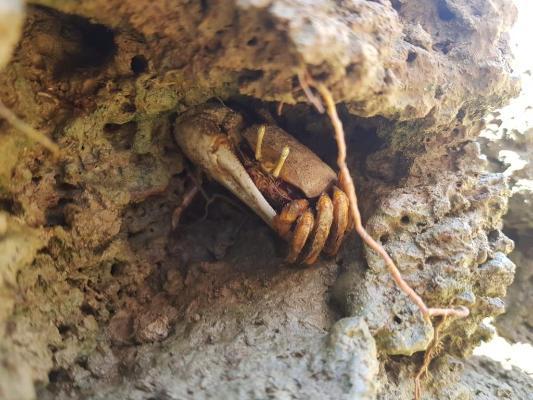
Picture of European Fiddler crab (Uca tangeri) in the Amoreira Estuary Photo: Afonso Thies
For the geological aspect, we focused on the rock types and sedimentation of the estuary. Core samples were taken to assess and to investigate whether there was evidence of the 1755 Tsunami in the region. From the core sampling, possible tsunamitos have been identified and picture evidence has been taken for further analysis. As part of the land use assessment, innovative ideas were suggested to re-invent a use for existing aquaculture ponds and the surrounding salinas in the estuary. A conservation and wildlife sanctuary has been proposed (mind map attached) for educational purposes with marine classrooms and displays of native plant and animal wildlife. It was also suggested to have an Integrated multi-trophic aquaculture (IMTA) in some ponds, which would reduce waste and recycle nutrients within the ponds. The IMTA could would also add to the educational aspect for local people and tourists on aquaculture and the history of the area.
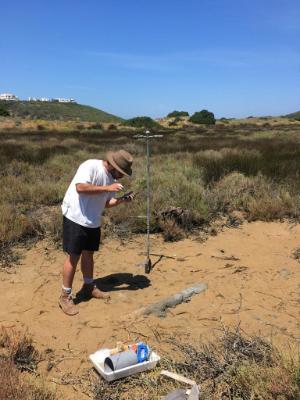
Core Sampling Photo: Dean Anthony Notaro
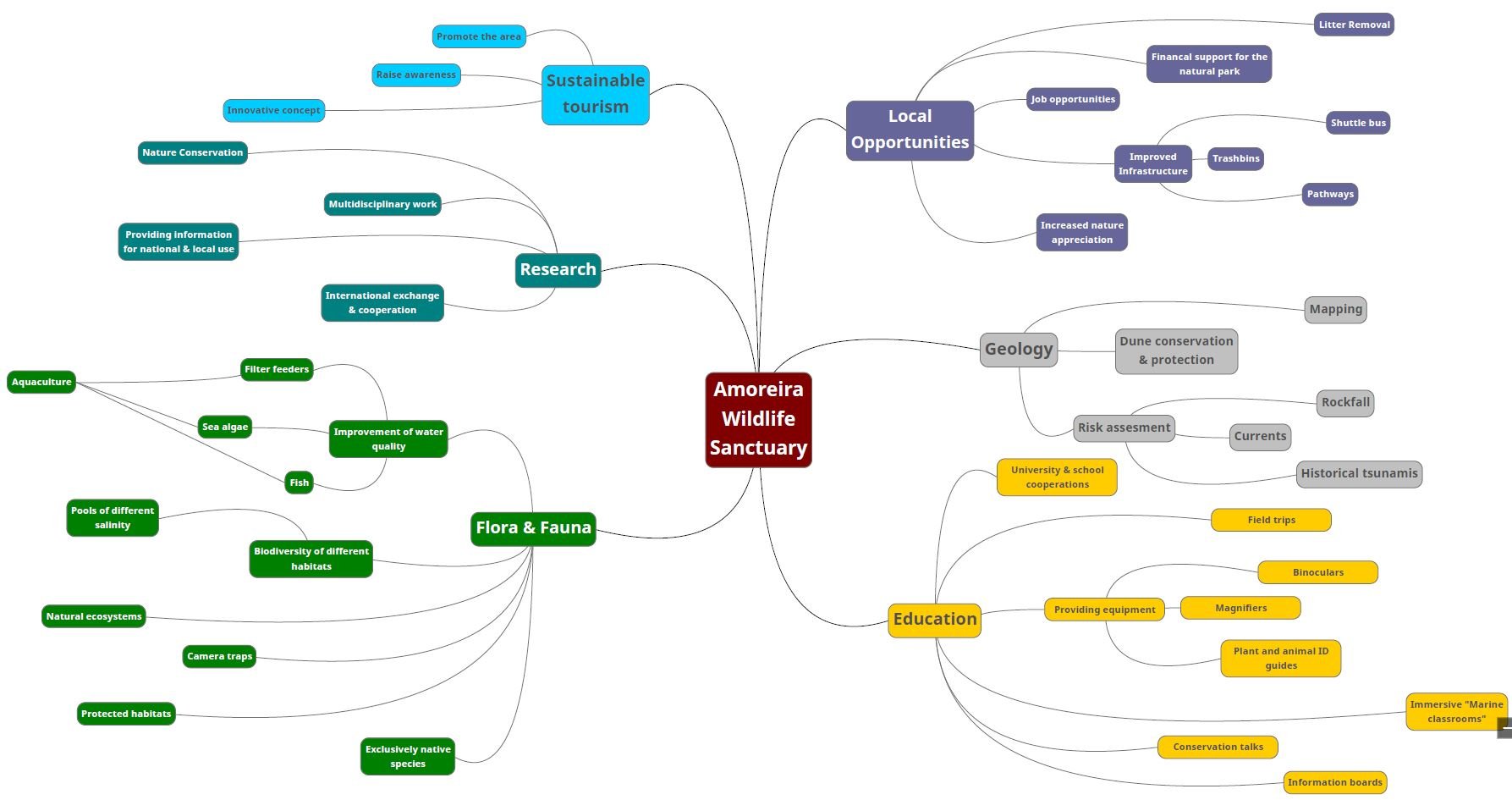
Mind map of proposed Amoreira Wildlife Sanctuary Photo: Emma Hadré
After several days in the field, the group scheduled a day of adventure. Some of us went on a Dolphin watching tour, of the coast of Sagres, Algarve. The tour was a truly amazing experience and we managed to observe three pods of common Dolphins (Delphinus delphis), some nesting sites of the European shag (Phalacrocorax aristotelis), within caves along the coast, as well as, foraging Gannets (Morus bassanus), both adults and juveniles. After the Dolphin watch tour, we had lunch at a local seafood restaurant. A combination of seafood dishes were tasted, from Octopus salad to red snapper, hake fish and veggie burgers. Following a very satisfying lunch, we headed back to Arrifana beach, to do a surfing class with a local surf school. We spent the afternoon getting surfing lessons and riding the waves. To finish off the amazing day, we all went out to a local pizzeria, where we wined and dined and reminisced on the wonderful week we have had so far
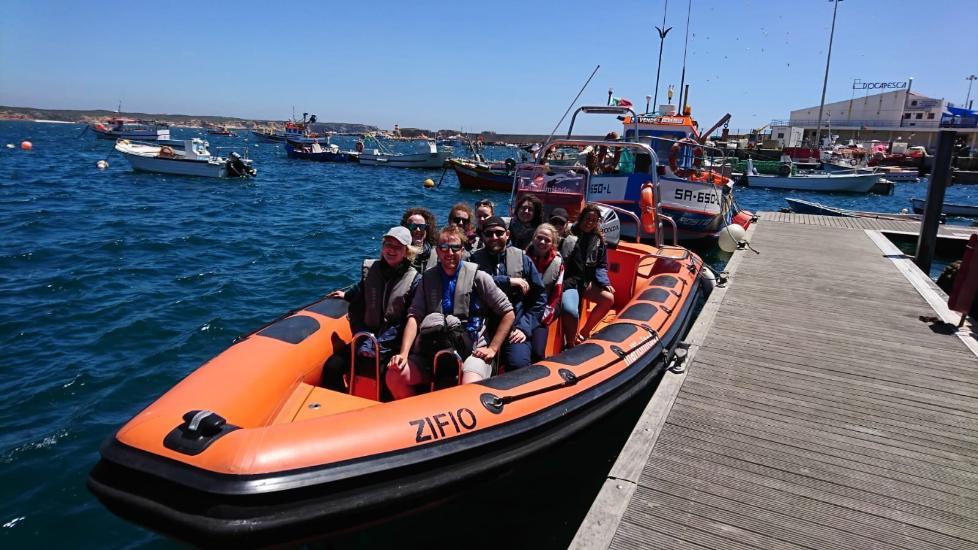
Dolphin watch Tour Sagres, Algarve Photo: Gary Kett
Team: Emma Hadré (Geographer), Afonso Thies (Geologist), Gary Kett (Biologist) and Dean Anthony Notaro (Biologist)
Project Area: Amoreira Estuary, Aljezur, Portugal

Hallo! Mein Name ist Dean Anthony Notaro und ich bin Masterstudent in mariner Biologie am University College Cork (UCC) in Irland. Zur Zeit arbeite ich an der Gesundheit von Schalentieren und schaue mir dafür verschiedene Therapieansätze an. Diese sollen helfen, bakterielle und virale Krankheitserreger in Schalentieren zu reduzieren. Der Schwerpunkt meiner Forschung liegt auf der pazifischen Auster (Crassostrea gigas). Ich bin eines von vier Mitgliedern des Estuar-Teams hier in Aljezur in Portugal. Unsere Gruppe besteht aus zwei Biologen der UCC in Irland, einem Geologen der Universität Lissabonn in Portugal und einer Geographin der Universität Osnabrück in Deutschland.
Als ein Teil unseres Projekts beschäftigen wir uns mit den verschiedenen Habitaten im Estuar des Amoreira-Flusses. Wir erforschen die Ökologie der Region, zum Beispiel indem wir die Vegetation in den Sanddünen beobachten oder Plankton, Infauna und andere Lebewesen im Flussgebiet sammeln. Zusätzlich haben wir die geolgische Landschaft der umliegenden Talwände erforscht, und Ideen für eine potentielle Landnutzung entwickelt um den Naturschutz und Tourismus in der Gegend zu unterstützen. Unser Projekt besteht aus den drei Bereichen Geologie, Biologie und Landnnutzung, wobei jedes der Teammitglieder interdisziplinär gearbeitet hat.
Für den biologischen Teil haben wir uns mit verschiedenen Pflanzen- und Tierarten in den Dünen und Marschgebieten beschäftigt. Um eine Bestandsaufnahme durchzuführen haben wir 5×5 Meter Gebiete abgesteckt, und mithilfe eines Protokolls den Inhalt festgehalten. Pro Habitat haben wir fünf solcher Quadrate erhoben. Für die Benthosfauna haben wir pro Gebiet 3×3 Zylinderkerne ausgehoben, in einem Netz den Sand herausgewaschen und die verschiedenen Spezies ausgewertet. Wir haben verschiedene Arten von Amphipoden, Würmern und Muscheln gefunden. Mit Planktonnetzen haben wir an verschiedenen Stellen des Flusses den Planktongehalt gemessen. An selbigen Stellen haben wir auch die Temperatur und Salinität des Wassers gemessen um herauszufinden, warum bestimmte Arten diese Orte bewohnen. Während unserer Feldarbeit haben wir eine Population von Winkerkrabben (Uca tangeri) entdeckt. Die war eine große Überraschung, da diese Art zuvor in der Gegend noch nicht beobachtet wurde. Wir haben beschlossen, an drei zufällig gewählten Stellen die Anzahl der Krabben, Höhlen, Oberflächen- und Höhentemperatur in Gebieten von 10×2 Metern zu erheben.
Für den geologischen Bereich haben wir uns näher mit den Steinen und Sedimenten im Flussgebiet beschäftigt. In Bohrkernen die wir genommen haben konnten wir beobachten, ob Sedimente des Tsunamis 1755 in der Region vorhanden waren. Solche Sedimentablagerungen wurden mit großer Wahrscheinlichkeit gefunden, auf Fotos aufgenommen und werden nun weiter auf ihren Ursprung hin geprüft. Für die Landnutzung haben wir innovative Ideen entwickelt um eine bestehende, brachliegende Aquakulturanlage nachzunutzen. Es wurde vorgeschlagen, auf der Anlage eine Naturschutzstation einzurichten (siehe MindMap). Die Anlage soll Marine Klassenräume für Schulen und Universitäten besitzen und heimische Pflanzen und Tiere zeigen und schützen. Ein weiterer Vorschlag ist die Einrichtung von Aquakulturanlagen (Integrated multi-trophic aquaculture, IMTA). Diese würden Nährstoffe recyclen und Abfall reduzieren. Weiterhin würde eine solche Anlage die Möglichkeit bieten, das Besucher mehr über Aquakulturtechniken und die Geschichte der Region lernen.
Nach vielen Tagen im Feld hatten wir einen Tag frei um etwas zu unternehmen. Ein Teil der Gruppe entschied sich, eine Delfin-Bootstour in Sagres an der Algarve zu machen. Die Bootstour war eine beeindruckende Erfahrung. Wir konnten drei Gruppen von gemeinen Delfinen (Delphinus delphis) beobachten, eine Brutstätte der Krähenscharbe (Phalacrocorax aristotelis) in einer Höhle an der Küste sowie einige Tölpel mit Jungtieren. Nach der Bootstour haben wir im Hafen frische Meeresfrüchte und Fische gegessen. Zurück in Aljezur haben wir am Nachmittag am Strand von Aljezur surfen gelernt. Der Nachmittag in den Wellen ging viel zu schnell vorbei, und später haben wir den Abend in der lokalen Pizzeria mit Wein ausklingen lassen und uns an die schöne Woche zurückerinnert.

